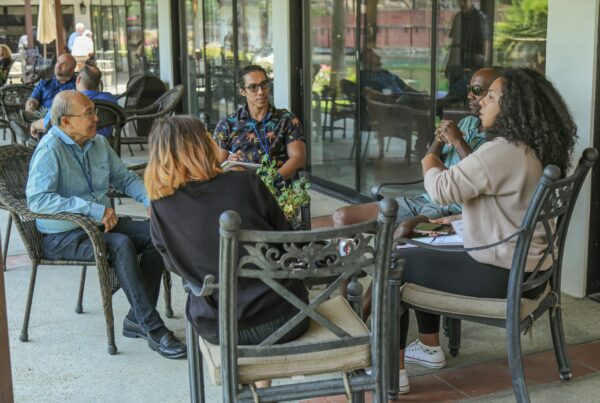Week 4 of the equity-based hospitality study
Objectives
- Actively pursue and intentionally embrace diversity and equity in race, gender, ability, age, vocation, ethnicity, and more.
- Be conscious of who is invited, who leads, and who is not in the room. With no distinction between tribe and nation, the Lord is the Lord of all.
Anchor verse: Romans 10:11-12 and Revelation 7:9
Romans 10:11-12: “As the Scriptures tell us, ‘Anyone who trusts in him will never be disgraced.’ Jew and Gentile are the same in this respect. They have the same Lord, who gives generously to all who call on him.”
Revelation 7:9: “After this I saw a vast crowd, too great to count, from every nation and tribe and people and language, standing in front of the throne and before the Lamb. They were clothed in white robes and held palm branches in their hands.”
What does it mean to be diverse?
Can you list all the areas in life that might be different from you? There’s ability, upbringing, culture, age, gender, and skin color, just to name a few. Diversity means different things in different contexts. For our purposes, we’ll be looking through the lens of congregations. But this can be customizable to different contexts and organizations. Diversity is a range of human experiences not limited to race, gender, age, etc.
Oxford Dictionary defines diversity as “the practice or quality of including or involving people from a range of different social and ethnic backgrounds and of different genders, and more.”
The trick with being a human who values diversity means you need to be okay with being around people who are different from you. It also means you need to be intentional. When we value diversity, we are curating spaces where people are welcome. This takes time. It’s not transactional. We need to consider what needs to change in our space in order to live out the value of having a diverse life.
Diverse people may have different values, politics, cultures, upbringings, abilities, ages, and racial backgrounds. Thought diversity and neurodiversity are as significant as diversity that we can see. We may not always be able to see ability diversity, either; many disabilities, both mental and physical, are as invisible to the naked eye as thought diversity. Surrounding yourself with all forms of diversity is important in order to open yourself up to being intentionally inclusive like Christ demonstrates for us.
Think about a high school campus during lunch. There are many different social groups in their own huddles. Tech students might hang in a different group from the football team. The robotics team might be diverse in gender, race, and ability, but may be similar in thought. The football team is usually one gender, and most of those on it have athletic ability. Of course, this is just a small slice of the various groups with various abilities that you might find in the cafeteria, but it gives you a picture of the ways people sort themselves into groups.
Students on a high school campus try to find “their people.” They look for where they feel a sense of belonging, where others are like them. This is normal, and adults do it, too. In fact, it’s what most of the world does.
That’s why it’s so important to think through worship services, Bible studies, and other gatherings through the lens of diversity ahead of time. It does not come naturally. Diversity doesn’t necessarily happen automatically. It goes against our instinct to seek out people like us. Yet, I’m continually reminded of 1 Corinthians 12 where we all have different gifts. Our gifts are vast and wide. Let’s encourage one another to celebrate with all people.
Intentionally seek out diverse people to preach, lead worship, and hold leadership voices at the leadership table(s). This is not about checking the box; rather, we are growing our leadership to represent the vision of the kingdom of heaven here on earth painted for us in Revelation 7:9. All tribes and tongues and nations are together. All of God’s children are represented in leadership.
Once, a hiring executive mentioned to me the need to hire for culture. This executive desired for everyone to be able to jive and enjoy the same things. I mentioned to this executive that although I understood—we all like to be around like-minded people—this is not healthy for an organization. Jesus modeled diverse people coming together to build the whole body of Christ. The church, Christ’s body, is not just a leg or heart. Often, we need to look for diverse skills and perspectives to compose a healthy, intelligent, whole community.
You may need to intentionally bring in outside groups to grow your cultural intelligence. For example, everyone understands the need to have self control and not put yourself in situations that could lead to trouble. But the “Billy Graham Rule”’ (that men should avoid being alone with women to whom they are not married) does not help women to succeed. Think about where your leadership decisions are being made. Are they casually being made on the golf course, or someplace similar?
I was once a part of a community where the leadership would mountain bike together. It was for fun and exercise. Often, great conversations would happen during those times. The creativity in those conversations led to amazing ideas. However, decisions were being made without the whole team. As a decision-making space, it limited access to people who are able to mountain bike. And in this case, the group included on these trips were all men, so gender was also a factor in who could participate and have a voice at the leadership table. Conversations around work and decisions need to take place when all are represented. Exhibiting self-control around those conversations is extremely important for intentional diversity.
What does inclusion mean?
Inclusion means that the right conditions are in place for each person to thrive. It’s in the culture of the congregation. Systems are set up to encourage and continue to build inclusion. Everyone is recognized and appreciated for their talents and perspectives. Everyone belongs and is valued. Inclusive systems foster collaboration. Inclusion is both a set of behaviors and a heart posture that encourages all to feel valued for their unique qualities and experience a sense of belonging.
Inclusion may not be neat and tidy. It’s often talked about as “coloring outside the lines.” Think about children at a fancy table. They will spill and might even break a dish. It can be messy. Yet we desire for children to be a part of our dinners and celebrate with us. Jesus welcomed the children to the table and so do we. But to accommodate them—and others who are different from us—sometimes we have to find additional resources or shift plans.
Inclusion might look like intentionally setting up intergenerational dinners designed to bring people together. Some people have what they call a “Supper 8,” or a small group gathering centered around meals, shared stories, and study together.
In simple terms, inclusion is getting in the mix to work together.
Jesus showed us how to do this, and not only with the children. In Matthew 8:3, he broke with social convention to touch the lepers so that they could be healed. He associated with sinners, making room for prostitutes and tax collectors in the kingdom of heaven. Jesus was sensitive to the needs of all people. He showed an all-inclusive compassion. He was intentional in inviting them to dinner, seeking them out, and welcoming them in.
What does it mean to be intentional?
I like the definition of intentional as being deliberate. It means to do something on purpose.
We must seek out ways to be diverse. People enjoy being with like-minded individuals, in familiar situations, and with those who share their background. This is natural. But this is where diversity is difficult. It’s not that we don’t want to be diverse; it’s that it takes being deliberate. We want to make sure we are intentionally giving everyone what they need to succeed. That involves being intentional in leadership, as well as being intentional about who is in your congregation.
Even if you have diversity in your congregation, but have one only ethnic group or gender in leadership and worship service segments, you are not truly diverse. Diversity needs to exist in all areas of the organization. It’s about authentic, true representation at the table of leadership and in your congregation.
One way to do this is to seek opportunities to listen to voices different from you. Join groups with people who are different from you.
Jesus simply asked. He went around and asked people to follow him. He invited disciples to join him. They left their professions and families to follow him. Jesus had a stance of openness and welcomed all. He looked up and saw Zacchaeus in a tree. He went out of his way to have dinner at his home when others mocked him. Jesus broke taboos of the day when he brought in a diverse leadership and following.
He took time to acknowledge those who touched him, he noticed the children, and he went to the woman at the well.
McKinsey & Company did a report in 2015 (“Diversity Matters”), which showed that companies with a high level of diversity were 35 percent more likely to perform above their industry’s national median return.
If it’s good for Jesus, it’s good for us in the church, too. Diversity will be a blessing and fruit in all areas of our lives, businesses, churches, and homes. Corporations are seeing the fruit of diversity. Jesus showed us the fruit of diversity. The church must exhibit the fruit of diversity as well.
Are you being purposeful to surround yourself with all types of diversity?
Are you being deliberate in creating spaces where all belong?
How do we find diverse people when our circles only have people similar to us?
- Set your intention to be diverse. Consider who you are. Race, gender, thought, ability, age, etc. Then list areas that are different. Pick one of those areas to start with. It’s okay to take one step at a time. In the last session of this series, we discussed finding an area to contribute that might have people different from you. This is a great place to start. Diversity is a process and not a program put in place to make everyone get along.
- Be humble. Understand that you are learning about different people who might see the world differently from you. One similarity does not mean everything about you is similar. Be ready to learn. Always check your attitude and make sure it is one of a loving Christ who welcomed and associated with people typically found on the margins. He repeatedly humbled himself, to the point of being ridiculed and killed on the cross.
- Be open to listening, and listen actively. Jesus asked a lot of questions and then he listened. Even though he knew the answer, he showed a willingness to listen. Everyone wants to be listened to. Make sure you are wanting to hear other people’s points of view.
- Talk with people who are different from you. Follow others on social media who are different from you. Listen to what they have to say and consider it. Do this with intentionality.
- Invite different people into your groups. Take inventory of your current groups. Are they diverse? If not, identify where diversity could grow. Invite people into your groups with the welcome and intentionality of Jesus.
- Join a diverse group. Join a book club, community group, or social media group with people who are different from you.
How do you welcome and help diverse people find belonging?
- Set up intentional areas of diversity.
- Ask people what they need. Bring them into leadership areas where they are making decisions.
- Continue growing in cultural intelligence.
- Remember that unity in worship is the goal: all tribes, tongues, and nations together in unity worshiping. This does not mean unity in thought or worship style necessarily, but that all people with their various beliefs and backgrounds come together. It’s the image of men and women in the upper room waiting for the Holy Spirit (Acts 2). We can look to examples like Jesus traveling with women in Luke 8, Paul with Lydia (Acts 16), and John having a vision of accepting others different from him (Acts 10).
- Be open to change. Unity does not mean conformity. It’s about learning to draw the circle wide to embrace new practices, music expression, and cultural norms. Worship might need to start later, children in worship might not be perfectly silent, liturgical dance might have a folkloric flavor, music might have global beats, instruments, languages, etc.
“And over all these virtues put on love, which binds them all together in perfect unity.”
–Colossians 3:14
Reflect
- Read 1 Peter 3:8, 1 Corinthians 1:10, Ephesians 4:3, Psalm 133:1, 2 Corinthians 13:11, Galatians 3:28, and Philippians 2:2. What do you discover from these verses?
- Read 1 Corinthians 12:12-14. Where do you fit in the body of Christ? Where can you invite someone different from you into the body of Christ?
- Read James 2:1-4. Consider where in your life or church you have been drawn to someone wealthy rather than poor, or shown favoritism toward someone more like you. What can you do differently next time?
- Where in your life can you be intentional in setting up spaces for equity-based hospitality?
- How can you set up those spaces to create a sense of belonging?
- Spend some time in prayer and note where in your life you can grow in the equity-based hospitality value of intentional diversity.



